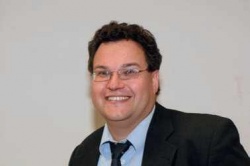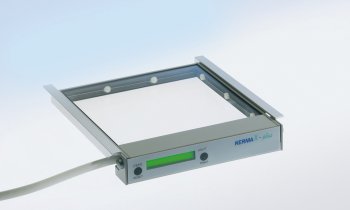Mathematical wizardry
A lot of maths and physics -- and good ideas
Having previously presented the CT D’OR (CT with Double Optimal Reading) and ‘Oped’ (Orthogonal Polynomial Expansion on the Disc), a detector mask and a reconstruction algorithm that improve image quality whilst simultaneously lowering the radiation dose, Professor Christoph Hoeschen, at the Department of Medical Radiation Physics and Diagnostics (AMSD) at the Helmholtz Centre Munich, is currently preoccupied with the development of new technologies for CT scanning.

responsible for a significant part of
medical radiation exposure amongst the
population. We are researching methods
to lower the radiation exposure of CT’
With ‘Watch’ (Well Advanced Technique for CT with High Resolution) scientists now have a further technological highlight available, which has a lot of potential.
As head of AMSD, Prof. Christoph Hoeschen’s motivation is easily explained: ‘Our objective is to improve the image quality of computer scanners whilst reducing the dose.’ Whoever believes this is a matter for physicists is wrong. When it comes to achieving dose reduction, there is in fact a lot of as yet undiscovered potential in the field of mathematics, as Prof. Hoeschen explains: ‘Radiation is required to generate images. The fewer data we need for mathematically correct image reconstruction the more we can lower the dose.’
Parallel beams
Existing scanners – CTs up to and including the 3rd generation – use reconstruction algorithms that are optimised for fan beams and which also reconstruct data from tilted projection. For these geometries, the ‘filtered back projection’ as well as modern iterative procedures and the above-mentioned Oped procedure can be used. ‘Watch’ is a geometry that samples parallel beams rather than fan beams, which can then be reconstructed with Oped.
During the process, ‘Watch’ requires a lower number of projections that also can be reconstructed into images in a shorter period of time. ‘The big advantage of the Watch geometry consists of the ability to generate parallel beam data sets that are optimally suited for reconstruction with Oped due to the distribution of the samples. With Watch geometry it’s even possible to generate parallel beams with a conventional X-ray tube, and also to reconstruct faster,’ explains engineer and medical physicist Thomas Forster.
Using a diagram, he clarifies a further advantage of parallel beam geometry: ‘The resolution of an image remains constant across the entire sectional plane. Furthermore, with Watch you have the ability to vary the focus-to-object distance to adapt the resolution according to requirements. With CT gantry systems the focus-to-object distance is fixed through the isocentre.’
Lower dose
‘In Germany, the collective radiation dose across the population from medical examinations is almost as high as the exposure to natural radiation. CT scanning is responsible for more than 50% of medical radiation exposure, although only 7% of all X-ray examinations are computer tomograms,’ explains Prof. Hoeschen, stressing that radiation dose reduction for patients during CT examinations is particularly important.
For Thomas Forster, the essential objectives in the further development of CT are to lower the dose still further through shorter scanning times while also increasing image quality. The Watch geometry is a further step in the right direction for AMSD scientists. The exclusive sampling of parallel, useful beams allows them to connect an effective collimator near the focus alongside the scattered radiation grid. Aided by the collimator, the scientists can blend out the X-rays that hit the gaps between the detector elements, thereby blending out the proportion of radiation that does not contribute towards imaging – which in turn lowers the radiation dose for patients.
The variable spatial resolution, or variable sampling respectively -- through a change of the angular velocity or integration time – as well as the homogeneity of the spatial resolution in the entire field of view are positive characteristics of future scanners.
Open and compact
The laboratory at the Helmholtz Centre has two Watch scanners set up because the geometry can be achieved with two different configurations: open and compact. The prototype of the open scanner is installed on a robot arm. The tube-detector-unit can be moved in any direction on a circular path around the fixed coordinate system of the object.
In the compact version, the tube and detector are located in a fixed coordinate system, whilst the object moves around the focus in a circular path.
The functioning prototypes have laid the theoretical base for a new CT concept. Now the scientists need to find cooperation partners who will help to take this project to a point where the equipment can go into serial production.
The ideas for the new generation of scanners developed from a joint project between AMSD and the ‘German Mouse Clinic’, which also has laboratories in the grounds of the Helmholtz-Centre in Munich. The clinic’s objective is the characterisation of human diseases using mouse models to better understand the molecular mechanisms of disturbed cell processes and to develop new treatments.
14.02.2012











